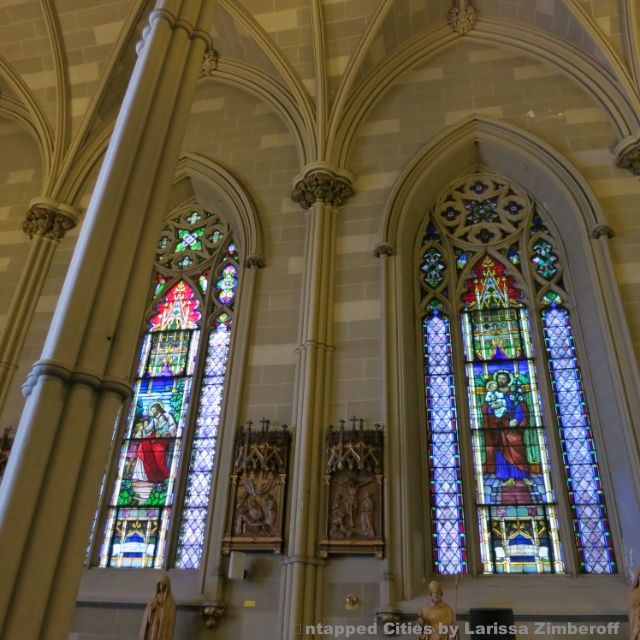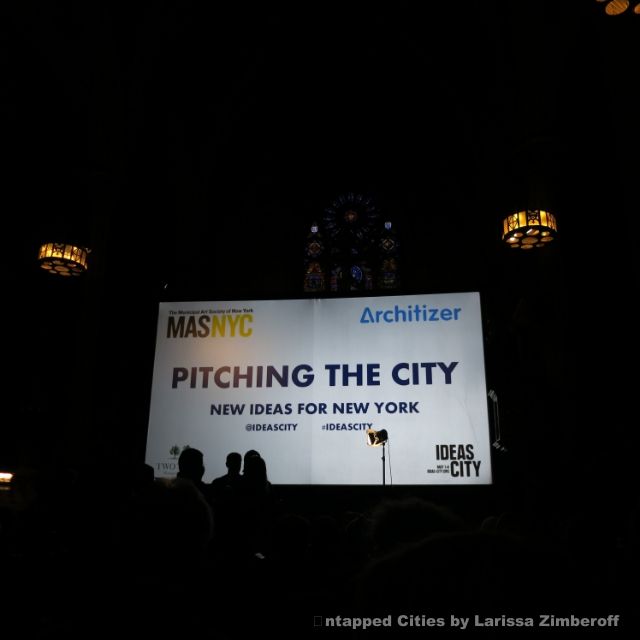Last Chance to Catch NYC's Holiday Notalgia Train
We met the voices of the NYC subway on our nostalgia ride this weekend!

The name “Ideas City” sounds just vague enough that it could be either a booth in a science fair or an aisle in FAO Schwarz, which both sound like a lot of fun. In reality it’s a collaborative of arts, education, and community organizations brought together by the New Museum, and tasked with the lofty goal of rethinking our cities. Began in 2011, Ideas City happens biennially in New York, with global conferences rotating annually. It will be in São Paulo this October.
This year’s festival was titled “Untapped Capital,” and focused on rethinking those New York resources that are underutilized or unrecognized. Last Friday was the event “Pitching the City,” which was sponsored by the Municipal Art Society and Architizer. The evening, aimed at opening up a venue for five firms to pitch some big ideas for New York, was held at St. Patrick’s Old Cathedral. Every pew in the church was taken up by the almost six hundred attendees, and, in place of the usual priest, was a giant media screen. It was a stimulating night of presentations that spoke to a wide range of the “unrecognized”: an unused subway cavern, the East River, Brooklyn Navy Yard, ageing phone booths, and an IRT powerhouse station.


Here’s a rundown of the ideas pitched, and links to where you can read more:
Pitch #1: The Lowline. Presented by Dan Barasch, the Lowline is envisioned to be a one-of-a-kind subterranean public park (including trees and grass), in a neighborhood known for its dearth of outdoor public spaces, the Lower East Side. The acre-size space earmarked for this project is the former Williamsburg trolley terminal, which discontinued service in 1948. The acre-size area is adjacent to the Delancey Street subway station. So, how exactly are those pretty green things going to get sun? With remote skylights of course, which will deliver sunlight below ground using advanced optical systems.
Pitch #2: Urbaneers. Presented by Mitchell Joachim from Terreform, an architectural and design think tank, Urbaneers, is a somewhat giant of an idea for transforming the Brooklyn Navy Yard, turbine building 128 to be exact, into a megalopolis of mixed-use classrooms, manufacturing startups, and more. Their website calls it a hub of innovation with an elevated aim: “a language of urban thinking that can create proximity between individual responsibility and the current global environment crisis.”
Pitch #3: + POOL. Dong-Ping Wong, the founder of + POOL began his presentation with this pithy line: “New York is surrounded by water,” and then launched into a description of his idea: a floating, water-filtering pool in the rivers of New York City. I know, it sounds a little out there doesn’t it? The pool, in the shape of a big plus sign, would float in the river, filled with recycled river water. Through its floating walls, made of concentric layers of filtration materials, + POOL will filter bacteria and contaminants–leaving only clean and safe river water. The Olympic-size pool is projected to filter over 500,000 gallons of river water daily, which leads us to the side job of the pool: helping to clean the city’s waterways.
Pitch #4: Hudson River Powerhouse. Presented by Alyssa Bishop, this idea was a re-imagining of a giant block-long building in Midtown. Built in 1904, the Beaux Arts building, designed by Stanford White, was once an IRT powerhouse (Interborough Rapid Transit), providing enough steam to power the subway system. Only a small portion of the building is being used by ConEd now, so there is more than half of a giant building to re-invent. The judges pointed out several issues in the concept, most notably about what to do with ConEd, but the bigger problem seemed to be honing in on what the non-profit wanted to do with the building: make it an energy museum or a performance space or a year-round market.
Pitch #5: NyFi. Presented by the architect Peter Coombe, NyFi (pronounced NyeFye) who proclaimed, “Payphones are dead.” The idea, to replace the obsolete phone booths around the city with sleek new models that could do a range of “wayfinding” tasks, for example: Wi-Fi hotspots, metro card dispensers, mapping systems, cellphone charging stations, and more. The new and improved booths would have digital advertisements, which is how they would make their money, and would fit in to the neighborhood appropriately. So, if the booth was in Times Square it could be gigantic, but if it were in the West Village it would be discreet to match the residential neighborhood.

In reality TV fashion, there was a panel of judges, flashed up on the big screen so even the back pews could see, who grilled the presenters after each pitch. The half dozen judges ranged from the media (Nick Denton at Gawker) to official (Megan Sheekey at the Mayor’s office), and credentialed (Christopher Sharples from SHoP Architects). The best response of the night came from the Mayor’s office and was lobbed over to + POOL, “So, it’s like a giant Brita filter?”
And then it was the audience’s turn to vote. We texted our top choice to a five-digit number, and then watched the real-time numbers add up on the big screen. We weren’t surprised with the news of the winner (the quirky and fun + POOL) but hoped that a few of our other favorites (the Lowline and NyFi) would also see some strong support. They did.
Now New York, sit back and wait to see what gets built first.
Subscribe to our newsletter